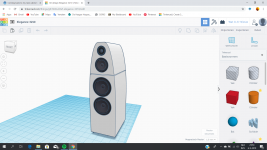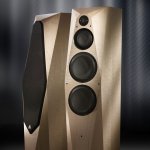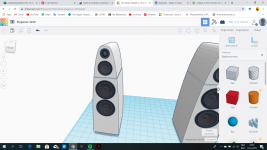Hello,
Vacation is over and I´m back thinking about the rebuilding of my speaker cabinets.
The previous concept was shaped round for very minimal difraction and internal standing waves and it would have been very strong because of the very thick walls and extensive bracing. Though it wasn´t prettiest and it won´t necessarily be hard to build but it was quite complicated and involved tonnes of (different) parts.
So now my new idea is inpired mainly by the Meridian DSP8000 and Marten Coltrane 3 and Tenor 2. A lot more elegant though my implementation would still offer more than enough volume and the midrange and tweeter will still be decoupled from the woofers. It doesn't have the round shape like that of the previous concept but I will make the edges slated by decent dimensions and I will likely line the baffle in felt to minimize baffle interference like Wilson Audio and Rockport Technologies do.
So that's the exterior pretty much out of the way. Now about making the cabinet rigid. I could make my life easy and just make the walls two inches thick but now that I'm studying industrial design I think I should something more advanced.
You've already told my about constrained layer damping and all of it's advantages before. And now seeing Sonus Faber come out with their new Olympica Nova series to use it and Rockport Technologies and Q Acoutics having already used constrained layer damping in their greatest speakers with great succes I think I should look further into it.
How should I take this on, and what materials should I use? I was thinking about making a 1 cm thick MDF inner and outer shell with a couple of cm of space in-between and fill that up with something. The inner shell will still have extensive bracing in it and the two inch thick baffle connected to it solidly. What material shoul I use to fill up the space in-between the shells. Polyurethane foam seems to be a popular choice but I don't think it will make for a particularry stiff result. What about epoxy? Fairly well damped I think, though extremely hard, rigid and strong. Working with that stuff is quite an effort but I have never done it before so I'm sure I can do it.
Let me know what you think and hive some suggestions for the construction
Vacation is over and I´m back thinking about the rebuilding of my speaker cabinets.
The previous concept was shaped round for very minimal difraction and internal standing waves and it would have been very strong because of the very thick walls and extensive bracing. Though it wasn´t prettiest and it won´t necessarily be hard to build but it was quite complicated and involved tonnes of (different) parts.
So now my new idea is inpired mainly by the Meridian DSP8000 and Marten Coltrane 3 and Tenor 2. A lot more elegant though my implementation would still offer more than enough volume and the midrange and tweeter will still be decoupled from the woofers. It doesn't have the round shape like that of the previous concept but I will make the edges slated by decent dimensions and I will likely line the baffle in felt to minimize baffle interference like Wilson Audio and Rockport Technologies do.
So that's the exterior pretty much out of the way. Now about making the cabinet rigid. I could make my life easy and just make the walls two inches thick but now that I'm studying industrial design I think I should something more advanced.
You've already told my about constrained layer damping and all of it's advantages before. And now seeing Sonus Faber come out with their new Olympica Nova series to use it and Rockport Technologies and Q Acoutics having already used constrained layer damping in their greatest speakers with great succes I think I should look further into it.
How should I take this on, and what materials should I use? I was thinking about making a 1 cm thick MDF inner and outer shell with a couple of cm of space in-between and fill that up with something. The inner shell will still have extensive bracing in it and the two inch thick baffle connected to it solidly. What material shoul I use to fill up the space in-between the shells. Polyurethane foam seems to be a popular choice but I don't think it will make for a particularry stiff result. What about epoxy? Fairly well damped I think, though extremely hard, rigid and strong. Working with that stuff is quite an effort but I have never done it before so I'm sure I can do it.
Let me know what you think and hive some suggestions for the construction
Sorbothane and lead lining speakers from Osborn and Whatmough speakers sound very transparent ,both options worth considering
Hi 3wayaddict!
Constrained layer damping... yes, nice technical choice, not so easy to apply in real life!
Your idea of 2 layers with a couple centimeters space filled by some materials doesn't really belong to cld. This is more decoupling than CLD.
These could work fine however.
For CLD usually the inner part is thin in thickness not in the centimeter range.
Check this, very interesting ( message #108):
constrained layer damping with MDF and Ply
Constrained layer damping... yes, nice technical choice, not so easy to apply in real life!
Your idea of 2 layers with a couple centimeters space filled by some materials doesn't really belong to cld. This is more decoupling than CLD.
These could work fine however.
For CLD usually the inner part is thin in thickness not in the centimeter range.
Check this, very interesting ( message #108):
constrained layer damping with MDF and Ply
...and here is what Earl Geddes told from his experience ( one page back the previous link i gave).
https://www.diyaudio.com/forums/mul...ned-layer-damping-mdf-ply-10.html#post5847929
https://www.diyaudio.com/forums/mul...ned-layer-damping-mdf-ply-10.html#post5847929
Well if you want to go CLD, here is a track you can follow:
Sony hold a patent about CLD where they used a multilayer Mdf/isodamp/Mdf.
In the patent ( i have acopy somewhere i can't find right now) there is two kind of 'sandwich' one for sub 100hz and another for 100hz and up cabinet design.
The sub 100hz is 2x 3/4 " each layer mdf and not so thin isodamp mat in between iirc. The 100hz and up is 1x3/4" mdf layer.
Isodamp is material from E-A-R company ( now owned by 3M). Not easy to source and not cheap at all.
Michael Percy offer some small size mat to buy.
E. Geddes once told in his own products he used melamine glue for the inner layer. Yes glue as a layer ( very thin).
Some more reading:
Loudspeaker construction
Sony hold a patent about CLD where they used a multilayer Mdf/isodamp/Mdf.
In the patent ( i have acopy somewhere i can't find right now) there is two kind of 'sandwich' one for sub 100hz and another for 100hz and up cabinet design.
The sub 100hz is 2x 3/4 " each layer mdf and not so thin isodamp mat in between iirc. The 100hz and up is 1x3/4" mdf layer.
Isodamp is material from E-A-R company ( now owned by 3M). Not easy to source and not cheap at all.
Michael Percy offer some small size mat to buy.
E. Geddes once told in his own products he used melamine glue for the inner layer. Yes glue as a layer ( very thin).
Some more reading:
Loudspeaker construction
I would probably spend my money on 22mm Baltic Birch plywood, and my design engineering on 3D bracing plus a low diffraction baffle (bevels or rounds)
I like the Avalon Compas beveled pyramid edge cuts around the TM top.
It is easier to use deep bevels to taper a low diffraction TM baffle top like the Avalon Compas, than to bend and glue several thin layers like the the Coltrane 3.
I like the Avalon Compas beveled pyramid edge cuts around the TM top.
It is easier to use deep bevels to taper a low diffraction TM baffle top like the Avalon Compas, than to bend and glue several thin layers like the the Coltrane 3.
Attachments
I've been to Chattelin again to listen to soms hoor stuff (Wilson Audio Sabrina on Zãnden amps connected to Grimm MU-1) to remind/reinspire myself how good sound can be and I've been reconsidering what base principle I should use for my own system. My room is quite tiny and it's suffering of the problem that I'm so close to the speakers that bass doesn't really come over that well. If I stand further back in the room, in the doorway, bass is much better bearable. Conclusion, the woofers should be further back. I was thinking about placing the woofers on the back of the cabinet but I doubt if that will be enough and even though low frequencies are rather omnidirectional I wonder what that will do with imaging and overall direction of the sound. What I think would be the best is totally separating the woofers from the main towers and placing them in the back corners of my room. Making triangular enclosures. Not only will this make the bass better hearable in the first place, it will also have alle the benefits of corner loading like the lack of reflecting back waves for example. This will also allow the main cabinets with the midrange and tweeter in them to be very small and slim which will allow better imaging and a more open soundstage. This is something I in particular noticed listening to the Sabrina's today. The had very good imaging and soundstage because of their very slim cabinets. Thoughts?
Hey Sven - are you planning active or passive? Keeping below 100Hz for the woofers would give freedom of placement without localisation issues.
Could you consider a cardioid design possibly for bass augmentation / reinforcement? it's not something I know anything about (curiosity) so take my advice with a grain of salt.
Could you consider a cardioid design possibly for bass augmentation / reinforcement? it's not something I know anything about (curiosity) so take my advice with a grain of salt.
Active as always. It´s my current system. Just a different box for it. Cardioid wasn´t the thing I´m thinking about doing. Rather complicated I think.
Right now I´m listening to some double bass and other bass on my system just to check but actually I think bass is hearable quite normally in the listening position.
But now I´m thinking about different bass principles, how about open baffle??? People who have them RAGE about just how good they sound. Could they be an option for my small room? Somebody know more about them?
Right now I´m listening to some double bass and other bass on my system just to check but actually I think bass is hearable quite normally in the listening position.
But now I´m thinking about different bass principles, how about open baffle??? People who have them RAGE about just how good they sound. Could they be an option for my small room? Somebody know more about them?
I don't really know anything about open baffle woofers but are 2 x 2 SB-Acoustics Satori WO24P-8's capable of deep and powerfull <20 Hz extension in a open baffle? Because that's quite necessary to me.
I think I'll stick with sealed for now. I know what I'm doing and what I can achieve with sealed. And great succes is guaranteed, it's not a guess.
I slimmed the cabinets down as much as possible. There's anly 1" around the tweeter to the edge, which will be slanted. The curve of the sides now starts all the way at the bottom, the entire sides are curved instead of starting the curve 40 cm from the bottom. This also helps preventing standing waves in the bass cabinet more. These cabinets are really slim around the tweeter and midrange right now, I'm sure this is gonna give great imaging and a very open and airy soundstage like that of those Sabrina's. I think it looks very good as well.
I slimmed the cabinets down as much as possible. There's anly 1" around the tweeter to the edge, which will be slanted. The curve of the sides now starts all the way at the bottom, the entire sides are curved instead of starting the curve 40 cm from the bottom. This also helps preventing standing waves in the bass cabinet more. These cabinets are really slim around the tweeter and midrange right now, I'm sure this is gonna give great imaging and a very open and airy soundstage like that of those Sabrina's. I think it looks very good as well.
Attachments
Last edited:
perhaps you could make that shape with 2 or 3 layers of 6mm 'bendy' ply? Might need a join or kerf cuts at the top though... anyone tried it?
I don't really know anything about open baffle woofers but are 2 x 2 SB-Acoustics Satori WO24P-8's capable of deep and powerfull <20 Hz extension in a open baffle? Because that's quite necessary to me.
IMO, no.
I had a 15" driver per side on OB for a little while. Took 27dB of boost to get flat to 25Hz, and at decent levels the cones were moving around 30mm p/p. The SB drivers are likely to have detonated by that point.
It does depend on your definition of "deep and powerful", though. IMO that starts at a ported 15" per side in a fairly small room. That's where the feeling of being shaken to your core starts.
HiFi drivers (and amps) won't cut it, if that's your goal.
Chris
- Home
- Loudspeakers
- Multi-Way
- Coming back to my new cabinets


